Unit IV
Staffing and Leading
In organizing, the manager determines as to what activities or jobs are required to achieve organizational goals. In staffing, the manager attempts to find out the right person for the right job. In fact, staffing is an important element of organizing.
Staffing function of management is concerned with the job of providing manpower with required skills for managing the organizational structure. It deals with recruitment, selection, placement, training, growth and development of the people working at various levels in the organization.
According to Theo Haiman, “The staffing function pertains to the recruitment, selection, development, training and compensation of subordinate managers.”
The main characteristics of a staffing are as follows:
1) Important managerial Function: Staffing is the most important managerial function along with planning, organizing, directing and controlling. The function of these four functions depends upon the manpower which is available through staffing function.
2) Pervasive Activity: Staffing function is carried out by all the managers and in all types of organization where business activities are carried out. It relates from top level management to middle level managers and finally to the lower level subordinates.
3) Continuous Activity: Staffing function continues throughout the life of an organization. It includes recruitments, transfers, promotions, etc. of the employees in an organization. Certain trainings are also given to the employees from time to time so as to perform better and contribute towards overall development of the business.
4) Efficient Management of personnel: Human resources can be efficiently managed by a system i.e. recruitment, selection, placement, training and development, providing remuneration, etc. All this provides a motivational force to the employee leading to the betterment of the organization as a whole.
5) Right men at Right Job: It can be done effectively through proper recruitment procedures and then finally selecting the most suitable candidate as per the job requirements. Staffing aims at selecting the right men for the right job at a right time.
6) Related with Human Resource management: This is mainly related with the people and not like planning, organizing, etc. which is related with paper work. It is concerned with the managers and employees of the organization.
7) Result –oriented Function: The staffing function places emphasis on results. All the sub-function of staffing aim at achievement higher efficiency and productivity.
8) Social Responsibility: This function is related with the recruitment, selection, training, etc. of the people, so it becomes the social responsibility of the person or department concerned with all the activities that they have to be impartial in taking proper and correct decision.
IMPORTANCE OF STAFFING:
1) Helps to achieve objectives: Staffing helps to achieve business objectives. Staffing helps in selecting, motivating and setting policies related to employees so that all other factors of production are put into efforts to achieve business objectives.
2) Improve Efficiency: Staffing includes training and development programme for type employees. Continuous training process helps the organization to adopt advance technology. This increases the efficiency of the employees.
3) Job Satisfaction: Staffing provides an opportunity to a right person to work at right place. It enables the people to put their team efforts to achieve targets. This indirectly provides job-satisfaction to employees.
4) Best utilization of Human factor: Staffing function of any organization is related with human factor. It tries to utilize human resources more efficiently and effectively. Through training and development programme the employees are made the best for their work.
5) Healthy industrial relations: Sound staffing leads to create healthy inter-personal relations among employees and management, superiors and subordinates, among the employees themselves etc.
6) Optimum use of resources: All the factors of production like machinery, material and money can be used at their optimum level with the help of efficient man-power. Staffing attempts to use all factors at highest level.
7) Human resource accounting: Human resource accounting is related with the record of expenses and incomes concerned to human factor. Human is treated as an asset in business organization. This new branch of accounting is a best tool for control.
8) Reduce Absenteeism and Employees turnover: Staffing includes selection, training, promotion of the employees in any organization. Staffing develops the job-satisfaction among the employees. This helps to reduce labour in absenteeism and employee’s turnover.
9) Managerial Development: Staffing is a function related with all level of management. It includes selection, recruitment, training, motivating and promotion etc. of employees. This develops the managerial skills at top and middle level.
4.2.1 Concept:
The term motivation is derived from the word ‘motive”. The word ‘motive’ as a noun means an objective, as a verb this word means moving into action. Therefore, motives are forces which induce people to act in a way, so as to ensure the fulfilment of a particular human need at a time. Behind every human action there is a motive. Therefore, management must provide motives to people to make them work for the organization.
Motivation may be defined as a planned managerial process, which stimulates people to work to the best of their capabilities, by providing them with motives, which are based on their unfulfilled needs.
“Motivation means a process of stimulating people to action to accomplish desired goods.” —William G. Scott
“Motivation is the process of attempting to influence others to do your will through the possibility of gain or reward.” — Flippo
Motivation is, in fact, pressing the right button to get the desired human behaviour.
Motivation is no doubt an essential ingredient of any Organisation. It is the psychological technique which really executes the plans and policies through the efforts of others.
Following are the outstanding Features of the concept of motivation:
1. Motivation is a personal and internal feeling:
Motivation is a psychological phenomenon which generates within an individual.
2. Motivation is need based:
If there are no needs of an individual, the process of motivation fails. It is a behavioural concept that directs human behaviour towards certain goals.
3. Motivation is a continuous process:
Because human wants are unlimited, therefore motivation is an ongoing process.
4. Motivation may be positive or negative:
A positive motivation promotes incentives to people while a negative motivation threatens the enforcement of disincentives.
5. Motivation is a planned process:
People differ in their approach, to respond to the process of motivation; as no two individuals could be motivated in an exactly similar manner. Accordingly, motivation is a psychological concept and a complex process.
6. Motivation is different from job satisfaction:
The process of motivation is illustrated in the figure given below:
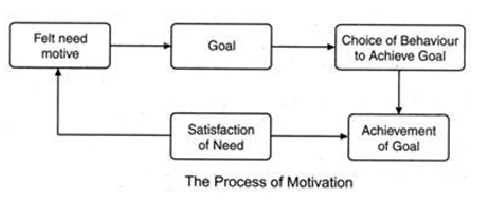
Figure shows an employee has a need or urge for promotion to a higher position. If this need is strong, the employee will fix his goal and find alternatives to reach the goal. They might have two alternatives, namely, (I) hard work and (ii) enhancement of qualification (e.g., getting MBA) and hard work.
The Process of Motivation
He might choose the second alternative and succeed in getting promotion (goal achievement) thus, his need for promotion would be satisfied and he would start again for the satisfaction of a new need.
4.2.2 Importance:
Motivation is an integral part of the process of direction.
While directing his subordinate, a manager must create and sustain in them the desire to work for the specified objectives:
1. High Efficiency:
A good motivational system releases the immense untapped reservoirs of physical and mental capabilities. A number of studies have shown that motivation plays a crucial role in determining the level of performance. “Poorly motivated people can nullify the soundest organisation.” said Allen.
By satisfying human needs motivation helps in increasing productivity. Better utilisation of resources lowers cost of operations. Motivation is always goal directed. Therefore, higher the level of motivation, greater is the degree of goal accomplishment.
2. Better Image:
A firm that provides opportunities for financial and personal advancement has a better image in the employment market. People prefer to work for an enterprise because of opportunity for development, and sympathetic outlook. This helps in attracting qualified personnel and simplifies the staffing function.
3. Facilitates Change:
Effective motivation helps to overcome resistance to change and negative attitude on the part of employees like restriction of output. Satisfied workers take interest in new organizational goals and are more receptive to changes that management wants to introduce in order to improve efficiency of operations.
4. Human Relations:
Effective motivation creates job satisfaction which results in cordial relations between employer and employees. Industrial disputes, labour absenteeism and turnover are reduced with consequent benefits. Motivation helps to solve the central problem of management, i.e., effective use of human resources. Without motivation the workers may not put their best efforts and may seek satisfaction of their needs outside the organisation.
The success of any organisation depends upon the optimum utilisation of resources. The utilisation of physical resources depends upon the ability to work and the willingness to work of the employees. In practice, ability is not the problem but necessary will to work is lacking. Motivation is the main tool for building such a will. It is for this reason that Rensis Likert said, “Motivation is the core of management.” It is the key to management in action.
4.2.3 Extrinsic and Intrinsic Motivation:
Definitions of Intrinsic and Extrinsic Motivation
Intrinsic motivation involves doing something because it's personally rewarding to you. Extrinsic motivation involves doing something because you want to earn a reward or avoid punishment.
Examples of extrinsic motivation could include:
- Reading a book to prepare for a test
- Exercising to lose weight
- Cleaning your home to prepare for visitors coming over
Examples of intrinsic motivation could include:
- Reading a book because you enjoy the storytelling
- Exercising because you want to relieve stress
- Cleaning your home because it helps you feel organized
4.3.1 Maslow’s Need Hierarchy Theory:
It is probably safe to say that the most well-known theory of motivation is Maslow’s need hierarchy theory Maslow’s theory is based on the human needs. Drawing chiefly on his clinical experience, he classified all human needs into a hierarchical manner from the lower to the higher order.
In essence, he believed that once a given level of need is satisfied, it no longer serves to motivate man. Then, the next higher level of need has to be activated in order to motivate the man. Maslow identified five levels in his need hierarchy as shown in figure 17.2.
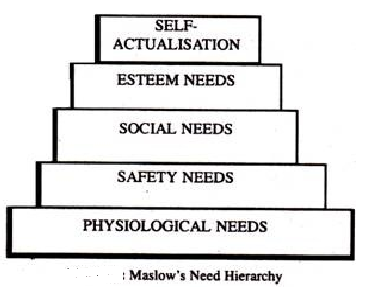
These are now discussed one by one:
1. Physiological Needs: These needs are basic to human life and, hence, include food, clothing, shelter, air, water and necessities of life. These needs relate to the survival and maintenance of human life. They exert tremendous influence on human behaviors. These needs are to be met first at least partly before higher level needs emerge. Once physiological needs are satisfied, they no longer motivate the man.
2. Safety Needs: After satisfying the physiological needs, the next needs felt are called safety and security needs. These needs find expression in such desires as economic security and protection from physical dangers. Meeting these needs requires more money and, hence, the individual is prompted to work more. Like physiological needs, these become inactive once they are satisfied.
3. Social Needs: Man is a social being. He is, therefore, interested in social interaction, companionship, belongingness, etc. It is this socializing and belongingness why individuals prefer to work in groups and especially older people go to work.
4. Esteem Needs: These needs refer to self-esteem and self-respect. They include such needs which indicate self-confidence, achievement, competence, knowledge and independence. The fulfillment of esteem needs leads to self-confidence, strength and capability of being useful in the organization. However, inability to fulfill these needs results in feeling like inferiority, weakness and helplessness.
5. Self-Actualization Needs: This level represents the culmination of all the lower, intermediate, and higher needs of human beings. In other words, the final step under the need hierarchy model is the need for self-actualization. This refers to fulfillment’s term self-actualization was coined by Kurt Goldstein and means to become actualized in what one is potentially good at. In effect, self- actualization is the person’s motivation to transform perception of self into reality.
According to Maslow, the human needs follow a definite sequence of domination. The second need does not arise until the first is reasonably satisfied, and the third need does not emerge until the first two needs have been reasonably satisfied and it goes on. The other side of the need hierarchy is that human needs are unlimited. However, Maslow’s need hierarchy-theory is not without its detractors.
The main criticisms of the theory include the following:
1. The needs may or may not follow a definite hierarchical order. So, to say, there may be overlapping in need hierarchy. For example, even if safety need is not satisfied, the social need may emerge.
2. The need priority model may not apply at all times in all places.
3. Researches show that man’s behaviors at any time is mostly guided by multiplicity of behaviors. Hence, Maslow’s preposition that one need is satisfied at one time is also of doubtful validity.
4. In case of some people, the level of motivation may be permanently lower. For example, a person suffering from chronic unemployment may remain satisfied for the rest of his life if only he/she can get enough food.
Notwithstanding, Maslow’s need hierarchy theory has received wide recognition, particularly among practicing managers. This can be attributed to the theory’s intuitive logic and easy to understand. One researcher came to the conclusion that theories that are intuitively strong die hard’.
4.3.2 Hertzberg’s Two factor theory:
The psychologist Frederick Herzberg extended the work of Maslow and proposed a replacement motivation theory popularly referred to as Herzberg’s Motivation Hygiene (Two-Factor) Theory. Herzberg conducted a widely reported motivational study on 200 accountants and engineers employed by firms in and around Western Pennsylvania.
He asked these people to explain two important incidents at their jobs:
(1) When did you feel particularly good about your job, and
(2) When did you feel exceptionally bad about your job? He used the critical incident method of obtaining data.
The responses when analysed were found quite interesting and fairly consistent. The replies respondents gave once they felt good about their jobs were significantly different from the replies given once they felt bad. Reported good feelings were generally related to job satisfaction, whereas bad feeling with job dissatisfaction. Herzberg labelled the work satisfiers motivators, and he called job dissatisfies hygiene or maintenance factors. Taken together, the motivators and hygiene factors have become referred to as Herzberg’s two-factor theory of motivation.
Herzberg’s motivational and hygiene factors are shown in the Table 17.1
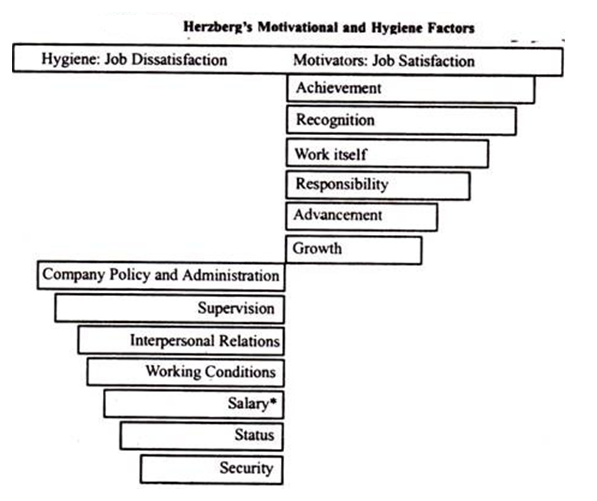
According to Herzberg, the other of satisfaction isn't dissatisfaction. The underlying reason, he says, is that removal of dissatisfying characteristics from a job doesn't necessarily make the job satisfying. He believes in the existence of a dual continuum. The other of ‘satisfaction’ is ‘no satisfaction’ and therefore the opposite of ‘dissatisfaction’ is ‘no dissatisfaction’.
According to Herzberg, today’s motivators are tomorrow’s hygiene because the latter stop influencing the behaviour of persons once they get them. Accordingly, one’s hygiene could also be the motivator of another.
However, Herzberg’s model is labelled with the subsequent criticism also:
1. People have a tendency to take credit themselves when things go well. They blame failure on the external environment.
2. The theory basically explains job satisfaction, not motivation.
3. Even job satisfaction isn't measured on an overall basis. It's not unlikely that an individual may dislike a part of his/ her job, still thinks the job acceptable.
4. This theory neglects situational variable to motivate an individual.
Because of its ubiquitous nature, salary commonly shows up as a motivator also as hygiene. Regardless of criticism, Herzberg’s ‘two-factor motivation theory’ has been widely read and a few managers seem untaminar together with his recommendations. The most use of his recommendations lies in planning and controlling of employee’s work.
4.3.3 Vroom’s Expectation Theory:
Vroom's expectancy theory assumes that behaviour results from conscious choices among alternatives whose purpose it is to maximize pleasure and to minimize pain. Vroom realized that an employee's performance is based on individual factors such as personality, skills, knowledge, experience and abilities.
He stated that effort, performance and motivation are linked in a person's motivation. He uses the variables Expectancy, Instrumentality and Valence to account for this.
Expectancy is the belief that increased effort will lead to increased performance .This is affected by such things as:
- Having the right resources available (e.g. Raw materials, time)
- Having the right skills to do the job
- Having the necessary support to get the job done (e.g. Supervisor support, or correct information on the job)
Instrumentality is the belief that if you perform well that a valued outcome will be receives. This is affected by such things as:
- Clear understanding of the relationship between performance and outcomes
- Trust in the people who will take the decisions on who gets what outcome
- Transparency of the process that decides who gets what outcome
Valence is the importance that the individual places upon the expected outcome.
The three elements are important behind choosing one element over another because they are clearly defined: effort-performance expectancy (E>P expectancy) and performance-outcome expectancy (P>O expectancy).
E>P expectancy: our assessment of the probability that our efforts will lead to the required performance level.
P>O expectancy: our assessment of the probability that our successful performance will lead to certain outcomes.
4.4.1 Concept:
Leaders and their leadership skills play an important role in the growth of any organization. Leadership refers to the process of influencing the behaviour of people in a manner that they strive willingly and enthusiastically towards the achievement of group objectives.
A leader should have the ability to maintain good interpersonal relations with the followers or subordinates and motivate them to help in achieving the organizational objectives.
Leadership is an art whereby an individual influences a group of individuals for achieving a common set of goals. To expand it further, leadership is a process of inter-personal relationships through which a person attempts to influence the behaviour of others for attainment of pre-determined objectives. Of the various people, who have defined leadership, influence and attainment of objectives are the common denominators.
CHARACTERISTICS OF LEADERSHIP:
On the basis of an analysis of different definitions, following characteristics of leadership emerge:
1. Leadership is a process of Influence:
Influence is the ability of an individual to change the behaviour, attitude, and belief of another individual directly or indirectly. Someone has rightly defined leaderships as the “process of social influence in which one person can enlist the aid and support of others in the accomplishment of a common task”.
2. Leadership is not one-dimensional:
The Essence of leadership is Followership. Leadership is a system thinking in multiple dimensions. In terms of systems thinking, the organizational performers (followers) are must in the leadership process. Without followers there can be no leadership.
3. Leadership is Multi-faceted:
Leadership is a combination of personality and tangible skills (drive, integrity, self-confidence, attractive personality, decisiveness, etc), styles (Authoritarian to laissez-faire), and situational factors (organisation’s internal and external environment, objectives, tasks, resources, and cultural values of leaders and the followers).
4. Leadership is Goal oriented:
Leadership is “organizing a group of people to achieve a common goal.” Thus, the influence concerns the goals only. Outside the goals, the concerns are not related to leadership.
5. Leadership is not primarily a Particular Personality Trait:
A trait closely linked to leadership is charisma, but many people who have charisma (for example, movie actors and sports heroes) are not leaders.
6. Leadership is not primarily a Formal Position:
There have been many great leaders who did not hold high positions—for example, Mahatma Gandhi, Martin Luther King, Jr. And—and Anna Hazare. On the other hand, there are people who hold high positions but are not leaders.
7. Leadership is not primarily a Set of Important Objectives:
It involves getting things done.
8. Leadership is not primarily a Set of Behaviours:
Many leadership manuals suggest that leadership involves doing things such as delegating and providing inspiration and vision; but people who are not leaders can do these things, and some effective leaders don’t do them at all.
4.4.2 Importance:
Influence the behaviour of others: Leadership is an ability of an individual to influence the behaviour of other employees in the organization to achieve a common purpose or goal so that they are willingly co-operating with each other for the fulfilment of the same.
Inter-personal process: It is an interpersonal process between the leader and the followers. The relationship between the leader and the followers decides how efficiently and effectively the targets of the organization would be met.
Attainment of common organizational goals: The purpose of leadership is to guide the people in an organization to work towards the attainment of common organizational goals. The leader brings the people and their efforts together to achieve common goals.
Continuous process: Leadership is a continuous process. A leader has to guide his employees every time and also monitor them in order to make sure that their efforts are going in the same direction and that they are not deviating from their goals.
Group process: It is a group process that involves two or more people together interacting with each other. A leader cannot lead without the followers.
Dependent on the situation: It is situation bound as it all depends upon tackling the situations present. Thus, there is no single best style of leadership.
4.5.1 Likert’s scale theory:
Various kinds of rating scales have been developed to measure attitudes directly. The most widely used is the Likert scale in 1932.
Definition:
A Likert Scale is a scale used to measure the attitude wherein the respondents are asked to indicate the level of agreement or disagreement with the statements related to the stimulus objects.
The Likert scale is a five-point scale ranging from “strongly disagree” to “strongly agree” which is used to allow the individual to express how much they agree or disagree with a particular statement.

For the purpose of analysis, each statement is allotted a numerical score ranging from either 1 to 5 or -2 to +2. The analysis could be done item wise, or a total score can be computed by summing up all the items for each respondent. One of the advantages of a Likert scale is that it is easy to construct and administer.
4.5.2 Blake and Mouten’s Grid Theory:
Definition:
Robert Blake and Jane Mouton have developed the Managerial Grid, also called as a leadership grid. According to them, the leadership styles can be identified on the basis of manager’s concern for people and production.
The managerial grid identifies five leadership styles based on two behavioural dimensions as shown in the figure below:
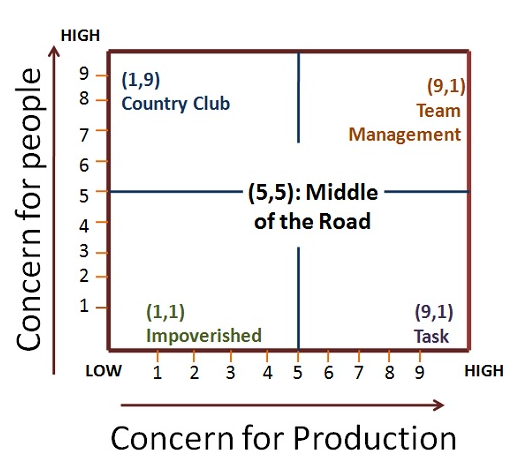
Impoverished Management (1,1): The managers with this leadership style exert minimum effort to get the work done by the subordinates. They have minimal concern for both the people and production.
Task Management (9,1): Here, the leader is more concerned with the production and lay less emphasis on the personal needs of his subordinates. This leadership style is also called as a dictatorial or perish style, where the subordinates are required to perform the task as directed by the superiors.
Middle of the Road (5,5): The manager with this style tries to keep a balance between the organizational goals and the personal needs of his subordinates.
Country Club (1,9): Here, the leader lays more emphasis on the personal needs of the subordinates and give less attention to the output. The manager adopts this style of leadership with the intent to have a friendly and comfortable working environment for the subordinates, who gets self-motivated and work harder on their own.
Team Management (9,9): According to Blake and Mouton, it is the most effective leadership style wherein the leader takes both people and production hand in hand.
4.5.3 Fred Fielder’s situational Leadership:
The Fiedler Contingency Model was created in the mid-1960s by Fred Fiedler, a scientist who studied the personality and characteristics of leaders.
The model states that there is no one best style of leadership. Instead, a leader's effectiveness is based on the situation. This is the result of two factors – "leadership style" and "situational favourableness" (later called "situational control").
Leadership Style
Identifying leadership style is the first step in using the model. Fiedler believed that leadership style is fixed, and it can be measured using a scale he developed called Least-Preferred Co-Worker (LPC) Scale
The scale asks you to think about the person you worked with and rate how you feel about this person for each factor, and add up your scores. If your total score is high, you're likely to be a relationship-orientated leader. If your total score is low, you're more likely to be task-orientated leader.
Scale
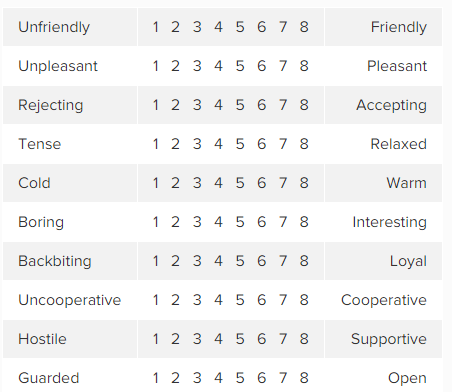
Situational Favourableness
Leader-Member Relations –A leader who is more trusted and has more influence within the group is in a more favourable situation than a leader who is not trusted.
Task Structure – This refers to the type of task you're doing: clear and structured, or vague and unstructured. Unstructured tasks, or tasks where the team and leader have little knowledge of how to achieve them, are viewed unfavourably.
Leader's Position Power – This is the amount of power you have to direct the group, and provide reward or punishment. The more power you have, the more favourable your situation.
Transactional leadership, as the word transaction implies, is based on an exchange process between the leader and the followers; followers working for the organisation and the leader reciprocating in terms of payment of wages/salaries and psychological benefits like status, recognition or esteem.
Features of transactional leadership:
Some features of transactional leadership are –
(I) Transactional leader focuses on task; and requires clear goals and appropriate instructions.
(ii) It requires appropriate role behaviour on the part of both the leader and the followers.
(iii) It puts leaders and followers on opposite sides. High task performance entitles followers to rewards; low task performance invites an exercise of legitimate and coercive power, on the part of the leader.
Leadership style behaviours under transactional leadership:
Following are some leadership style behaviours, popularly observed under transactional leadership:
(I) Active Management by Exception Behaviour:
To influence behaviour and performance of followers, the leader actively monitors work performed and uses coercive methods to ensure that the work is performed according to accepted standards.
(ii) Passive Management by Exception Behaviour:
Leader intervenes only if standards are not met and uses correction or coercive methods (i.e. punishment etc.) as a response to unacceptable performance i.e. deviation from the accepted standards.
(iii) Contingent Reward Behaviour:
The leader recognizes accomplishments of followers (i.e. when followers come up to the expectations of the leader) and promises rewards.
(iv) Laissez-faire leadership style:
The leader is indifferent and has a “hands-off” approach towards the workers and their performance. He avoids taking decisions and neither does he respond to problems of others nor monitor their performance.
Point of comment:
Under transactional leadership, followers may be so pressurized that they might be motivated to engage in unethical practices to claim rewards or avoid punishment.
The idea of transformational leadership was first developed by James McGregor Burns and later extended by Bernard Bass as well as by others. Transformational leadership, as the word transformation implies, aims at transforming the environment and the people in it; by building an appropriate context and enhancing the relationships of people, within the system.
Point of comment:
Transformational leadership is concerned with transforming the heart and mind of others, so as to achieve greater motivation, satisfaction and a greater sense of achievement. Political leaders like Mahatma Gandhi, Lenin etc. and business leaders like JRD Tata, GD Birla, Dhirubhai Ambani etc. made use of and practiced transformational leadership to achieve their missions to the best satisfaction of; self and others.
Assumptions of transformational leadership:
Fundamental assumptions of transformational leadership are:
(i) Everyone has a contribution to make
(ii) People can be and must be trusted.
(iii) Superiors are good coaches, mentors and models of ideal behaviour.
(iv) Complex problems should be handled at the lowest level.
(v) Norms are flexible and must be adapted to changing environment.
Process of transformational leadership: A broad process for exercising transformational leadership is suggested below:
(I) The leader must identify new opportunities with a long-term vision and inspire others with his/her vision of the future.
(ii) The leader must demonstrate himself/herself as an appropriate model of behaviour; setting an example for other to follow that behaviour towards attainment of common goals.
(iii) The leader must provide individualized support to others and show concern for personal feelings and need of others.
(iv) The leader must promote/ co-operation among employees, through his charismatic personality.
(v) The leader must provide intellectual stimulation to people; making them re-examine their assumptions about work.
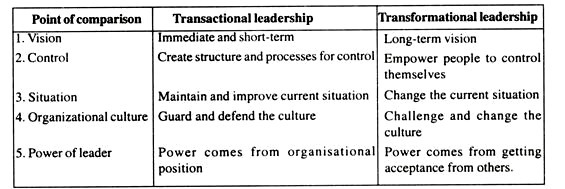
Transformational leadership is a leadership style in which leaders encourage, inspire and motivate employees to innovate and create change that will help grow and shape the future success of the company.
Transformational leaders inspire and motivate their workforce and trust trained employees to take authority over decisions in their assigned jobs.
The concept of transformational leadership started with James V. Downton in 1973 and was expanded by James Burns in 1978.
Transformational leadership characteristics
- Encourages the motivation and positive development of followers
- Exemplifies moral standards within the organization and encourages the same of others
- Fosters an ethical work environment with clear values, priorities and standards.
- Builds company culture by encouraging employees to move from an attitude of self-interest to a mindset where they are working for the common good
- Holds an emphasis on authenticity, cooperation and open communication
- Provides coaching and mentoring but allowing employees to make decisions and take ownership of tasks
The full range of leadership introduces four elements of transformational leadership:
- Individualized Consideration – the degree to which the leader achieves to each follower's needs, acts as a mentor or coach to the follower and listens to the follower's concerns and needs. The leader focus on giving empathy and support, keeps communication open and places challenges before the followers the followers have a will and aspirations for self development and have intrinsic motivation for their tasks.
2. Intellectual Stimulation – the degree to which the leader challenges assumptions, takes risks and solicits followers' ideas. Leaders encourages creativity in their followers. They nurture and develop people who think independently. Such a leaders see; learning is a value and unexpected situations as opportunities to learn. The followers think deeply about things , ask question and figure out better ways to execute their tasks.
3. Inspirational Motivation – the degree to which the leader articulates a vision that is appealing and inspiring to followers. Leaders with inspirational motivation challenge followers with high standards, communicate optimism about future goals, and provide meaning for the task at hand. Followers need to have a strong sense of purpose if they are to be motivated to act.
4. Idealized Influence – Provides a role model for high ethical behaviour, instils pride, gains respect and trust.